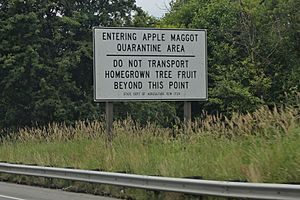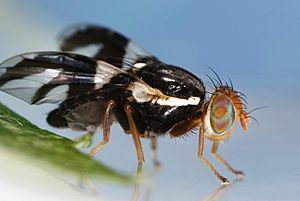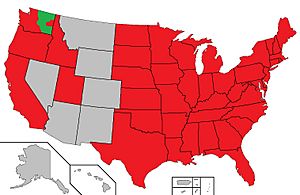Apple Maggot Quarantine Area facts for kids

The Apple Maggot Quarantine Area is a special zone in Washington state. It's a permanent quarantine, which means it's a way to stop something from spreading. Washington state law created this zone. The state's Department of Agriculture regularly checks and updates its borders. It started in the early 1980s. The main goal is to stop the apple maggot bug from spreading into parts of eastern Washington.
Contents
History of the Quarantine Area

The apple maggot bug is not naturally found in the Pacific Northwest. It was first found in Washington in 1980. After that, the quarantine began. Its purpose is to protect Washington's main apple farms from this bug. In 1985, the Washington State Department of Transportation put up 70 signs. These signs are on highways around the state to warn people about the quarantine.
The rules for this quarantine are part of Washington state law. They are found in Title 17 of the Revised Code of Washington.
Why the Quarantine is Important
Washington state grows a lot of apples. In 2016, Washington sold $718 million worth of apples to other places. This made apples the state's seventh biggest export. The apple is even the official state fruit. Almost two-thirds of all apples grown in the United States come from Washington.
The Washington Apple Commission says that Washington apples have very high quality rules. These rules are stricter than those in any other apple-growing area. All apples are picked by hand. They must pass a special inspection program. Their quality standards are even higher than those set by the United States Department of Agriculture.
The state's Department of Agriculture says the apple maggot threatens Washington's important apple industry. It also threatens many other fruit crops. If apple maggots spread widely in Washington, it could seriously harm the apple business. This could cause the state to lose its apple export markets.
Quarantine Rules and How They Work
How the Quarantine Works
Every year, the Washington state Department of Agriculture sets up traps. These traps catch apple maggots. They place between 5,500 and 8,500 traps each year. The traps are yellow sticky panels. They have a special smell that attracts the maggots.

If apple maggots are found in an area, officials study it more. They check fruit in that area for maggot larvae. Then, that area might become part of the quarantine zone. For example, in 2011, 35 apple maggots were found in 23 spots in Chelan County. This led to the quarantine zone being extended to the western part of that county.
Washington state has also placed other states under quarantine. These include Oregon, California, Idaho, and Utah. Also, all areas in the eastern United States are quarantined. Any foreign countries where the apple maggot lives are also under quarantine. As of 2017, parts or all of many Washington counties are also quarantined. These include Chelan, Clallam, Clark, Cowlitz, Grays Harbor, Island, Jefferson, King, Kitsap, Klickitat, Lewis, Lincoln, Mason, Pacific, Pierce, Snohomish, Spokane, Skagit, Skamania, Thurston, Wahkiakum, Whatcom, and Yakima.
The Tree Fruit Research and Extension Center at Washington State University says the quarantine works well. They point out that apple maggots have never been found in apples packed for sale in the state.
What You Can and Cannot Do
You are not allowed to move fruit grown at home or picked from the wild. This fruit cannot go from the quarantine zone into the pest-free zone. However, you can move fruit if it has been canned, juiced, or dried.
Also, any yard waste from the quarantine zone must stay there. It cannot be moved across the zone's borders. Fruit bought from stores is allowed. This is because store-bought fruit is already checked by state officials.
State law also allows pest control officials to order property owners. They can tell owners to spray pesticides on trees. This happens if apple maggots have been seen in those trees.
See Also
- Apple maggot
- Quarantine

